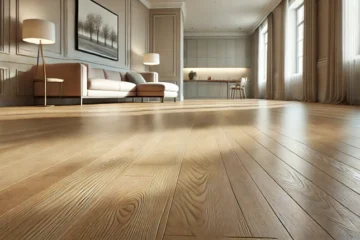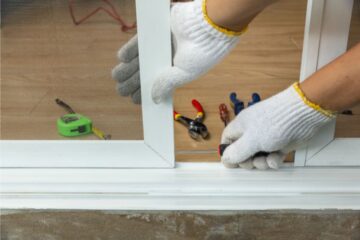Essential Interior Painting Supplies

Make sure you have all of your paint and supplies on hand before you start painting to avoid several journeys to the home improvement store in the middle of the project.
How Much Paint Should You Buy?
It’s impossible to estimate how much paint you’ll need to finish your project. However, you may estimate the amount of paint needed by estimating how many gallons it will take to cover the walls and ceilings of each room in a single coat. Grab a tape measure and follow these instructions to get started:
- Add up the horizontal lengths of all the walls in the room.
- To calculate the square footage of a room, multiply the amount by the height of the room.
- Divide the square footage by 350 to get an estimate of how much one gallon of paint can cover. The total number of gallons of paint you should purchase is the outcome (round to the nearest whole number).
- To figure out how many gallons of ceiling paint you’ll need, measure the length of the ceiling and multiply it by the breadth. Then multiply the result by 350.
If you buy more paint than you need, reseal the can or transfer the extra paint to an airtight container and keep it somewhere cold and dry. The paint should last a few years if properly stored.
Painter’s Toolbox
Gather the following materials before removing the lid on your first can of paint:
1. Paint rollers are made up of two parts: a steel roller frame set on a plastic handle and a replaceable synthetic-fiber roller cover glued to a 9″ plastic tube.
2. Roller tray: This paint reservoir has a large enough area for you to fully load a roller without making a mess. A tray is typically 12″ wide and 16″ long.
3. Mini rollers: These paint-applying instruments come in a variety of sizes and forms, but they usually have 4″-wide covers. They fit right into a paint can, so there’s no need for a roller tray.
4. Paintbrushes: Paintbrushes come in a variety of bristle kinds. Natural bristles are ideal for oil-based paint, whereas synthetic bristles are best for latex paint. Brushes with a 2″ wide sash brush and a 3″ broad straight brush are common.
5. Caulk gun and caulk: After priming and before painting, use a caulk gun to inject caulk into minor holes and cracks. Silicone caulk is more resilient, but it’s a pain to work with. It’s easier to work with latex caulk.
6. Putty knife (about 1 1/2 inch) “A putty knife, which is wide, is useful for smoothing caulk and cleaning out crevices and tight corners before painting, especially when painting window frames.
7. ten “When using various colors near to each other, use this type of knife—or a less expensive plastic painting guard—to protect neighboring surfaces.
Paint pails, whether made of steel or plastic, allow you to work with paint without having to lug a full gallon can about with you. For lesser operations, use a 2 1/2-quart pail; for larger jobs, use a 5-quart pail.
9. Water bucket and sponge: Keep these items close by while using latex paint so you can clean up accidental drips and dirty parts of walls, ceilings, and trim.
10. Mineral spirits and paper towels: When dealing with alkyd or oil paints, mineral oil and paper towels are needed. Mineral oil odors are very powerful, so use it carefully.
11. Stirring tools: Stirring tools exist in a variety of shapes and sizes, but they all function in the same way. Use them to stir paint by hand or to automatically stir paint by attaching them to an electric drill, placing them in a paint can, and pressing the trigger.
12. Brush and roller cleaning tool: This type of tool is excellent for cleaning both brushes and rollers. Brushes should be used on the toothed side, while rollers should be used on the concave side.
Spray Painting
Spray paint can be applied using two types of tools: aerosol spray cans and spray guns.
- Aerosol spray cans: Using an aerosol spray can to paint irregularly shaped items like wall-mounted heat registers, radiators, and interior shutters is a terrific way to save time and money. Aerosol paint comes in a wide range of colors and is simple to use as long as the can is kept moving. Stopping while the button is depressed causes the paint to apply excessively thickly and run. Solvent-based paints are extremely combustible and emit unpleasant odors. When spray painting, always wear goggles and a mask, and never work near an open flame when using aerosol chemicals.
- Spray guns are a significant improvement over spray cans. They’re perfect for quickly applying a large amount of paint. Though spray painting outdoors is generally safe, you should consider hiring a professional for inside tasks because professionals are better suited to deal with the poor ventilation. For indoor spray painting, an HVLP (high volume/low pressure) sprayer is a popular choice. It uses an electric turbine to produce a low-pressure spray with some overspray. In contrast, a compressor system produces a high-pressure spray with a lot of dirty overspray.
More About Rollers
When picking a roller, width isn’t the only aspect to consider; substance is also important. Latex paints should be applied with synthetic rollers, while oil-based paints should be applied with wool rollers. Roller covers are also available in a variety of naps, or textures, to help with a variety of tasks.
- Rollers with a short nap: Typically 1/4″ “These thick rollers are used to apply enamel paint to very smooth, flat surfaces like floors and ceilings. To avoid paint splatters, use them slowly.
- Medium-nap rollers: These are the conventional coverings that most people are familiar with, measuring 3/8″ to 3/4″ deep. They’re made to spread paint on normal walls and ceilings and provide a stippled finish.
- All rollers with a nap of at least 1 inch are considered long-nap rollers “or even longer. These rollers are excellent for painting rough surfaces including stucco, brick, and concrete.
Protective Gear
Use the following safety equipment when painting.
- Paint droplets and fumes hanging in the air are protected by respirators. If you don’t have a respirator, open windows for ventilation and circulate air throughout the room with a floor fan.
- Goggles: When using a roller, especially on ceilings, these safety glasses are a requirement since they protect your eyes from minute, airborne paint drips.
- Plastic drop cloths are used to protect items in the room from paint damage. They provide a more secure foothold on the floor than the slick surface of plastic sheets.
- Painter’s tape covers window panes, hinges, countertop edges, and plumbing fixtures while also being easy to remove once the painting is finished.
- Glass Mask®, commonly known as liquid masking, is a fast-drying liquid barrier that protects glass from paint damage. The mask can be scraped off with a razor blade after the paint is dry.


